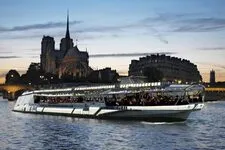Orangerie Museum: everything you need to know

Housing numerous Impressionist and Post-Impressionist paintings from the 19th and early 20th centuries, the Orangerie Museum is located in the Tuileries Garden, just steps away from the Place de la Concorde. It showcases the famous works of Paul Cézanne, Henri Matisse, Amedeo Modigliani, as well as Claude Monet, Pablo Picasso, Pierre-Auguste Renoir, and many other artists from that era.
From the Orangerie to the Museum
The name is not misleading; the Orangerie Museum is indeed housed in an old orangery, built in 1852 to shelter the tart citrus fruits of the Tuileries Garden in winter. Like all orangeries, the stone building was designed to be long, with glass on the Seine side (to the south) and walled on the garden side (to the north) to retain as much heat as possible. Its rather classic and sober decor blends perfectly with the surrounding neighborhood.
Transformed from the late 19th century until the early 20th century into a warehouse, military accommodation, and then a venue for various events (sports, music, horticultural, and even patriotic), the former orangery ultimately fell into the hands of the Fine Arts administration in 1921. This administration had grand plans for the orangery, wishing to house an annex to the Luxembourg Museum, which at that time constituted the current National Museum of Modern Art.
Monet's Installations
On the idea of the government leader of the time, Georges Clemenceau, Claude Monet was chosen to design the interior of the building. The famous painter created a stunning mural ensemble that he named the Water Lilies cycle and donated it to France. Spread over no less than two rooms specially designed for them, this series of 250 oil paintings is imbued with the bucolic atmosphere of the painter's property in Giverny and its famous lily pond.
Eight years passed between Monet's artistic donation and the museum's opening in 1927. Very inspired by the "Art Deco" style that was in vogue at the time, Monet decided on the museum's interior decoration himself, while being assisted by a true architect who ultimately served only as his right hand. At that time, the building had only one level. The Water Lilies occupied the entire eastern half of the museum, while the architect took care of arranging the other half of the building as an exhibition gallery. Strangely, Monet's Water Lilies did not yet generate great enthusiasm from the public, who flocked to the exhibitions presented in the museum's eastern wing. The temporary exhibition rooms are particularly small, covering only 500 m², yet they are the only ones (along with the Petit Palais) that can host large-scale ancient art exhibitions.
The Jean Walter and Paul Guillaume Collection
Between 1959 and 1963, the museum acquired the "Jean Walter and Paul Guillaume Collection" to create a distinct identity for the public. The collection consists of an admirable pictorial ensemble formed by the dealer and collector Paul Guillaume and his widow, Domenica, who remarried the architect Jean Walter. Renoir, Cézanne, Matisse, Picasso, Modigliani, Rousseau, and many other great artists make up the 144 works in the collection. It thus presents a superb testimony to fifty years of artistic creation in Paris, from the late 19th century to the early 20th century.
To house this prestigious collection, a new major construction project was opened on the site. During this work, the exhibition gallery was removed, and the building was divided into two levels. For the interior layout, Domenica requested the construction of a suite of salons, extending the entire length of the floor and overlooking an imposing staircase. Between 1978 and 1984, new work would further consolidate the museum and refresh the interior decor.
A New Breath for the Orangerie
Until the late 1970s, the Orangerie was one of the cultural highlights of Paris, thanks to its exhibition program and the late triumph of Monet's Water Lilies. However, powerful, more modern institutions, such as the Grand Palais, the Pompidou Center, and the Musée d'Orsay, began to compete with the Orangerie and made headlines. The Orangerie then seemed quite outdated, yet the public remained loyal to this modest museum, and the number of annual visitors increased from 200,000 in 1984 to 500,000 in 1998.
To address its lack of modernity, the Orangerie Museum embarked on a major renovation project aimed at revitalizing this small space. Thanks to the specificity of the collections, the artistic genius that occupies the place, and its cultural actions, the Orangerie ultimately managed to stand out. From 2000 to 2006, the latest renovations gave the museum a new face. The interior was rearranged, and the exterior was taken in hand by the famous chief architect of historical monuments, Michel Goutal. Finally, the Water Lilies were given an interior decor in harmony with their pictorial style, and the public was provided with welcoming conditions worthy of their loyalty!
With Come to Paris, you can access the exhibitions of the Orangerie Museum.
Activities in the Surroundings

The Orangerie Museum of Paris

Guided tour of Opera Garnier
